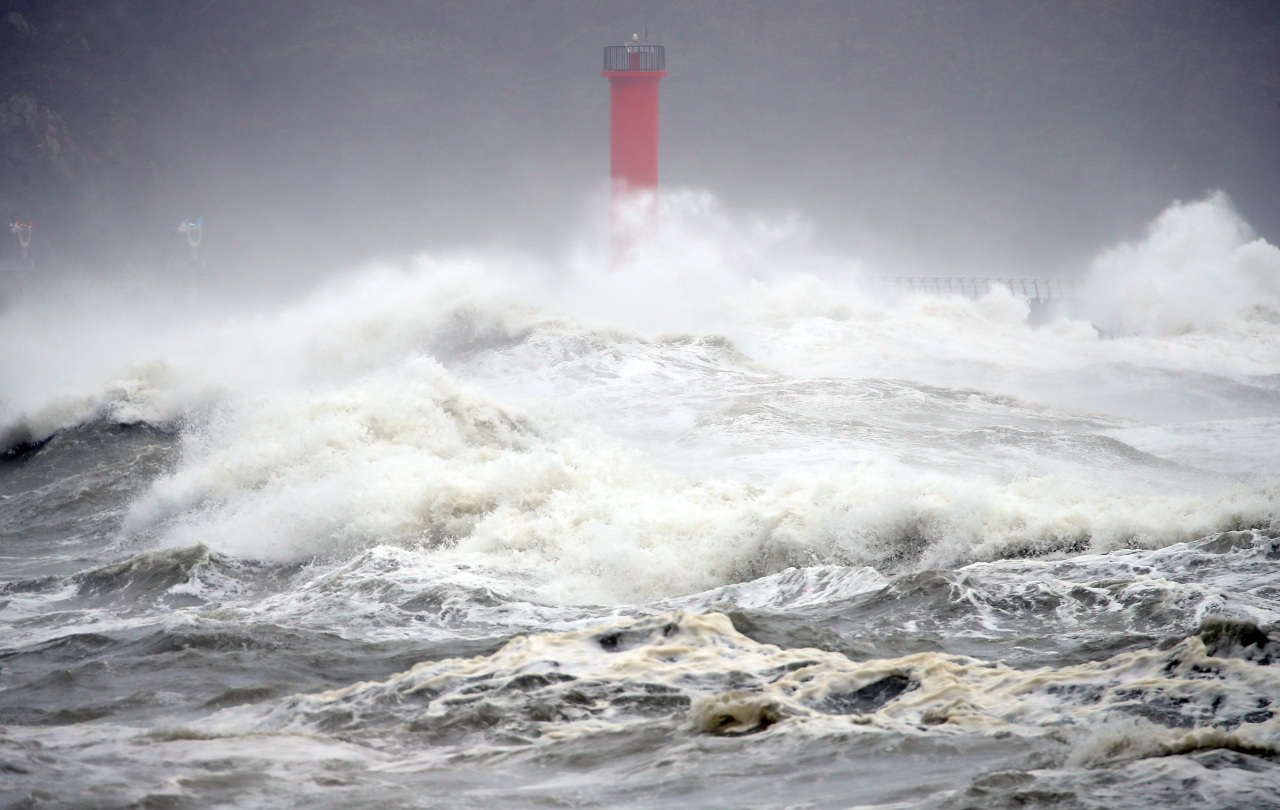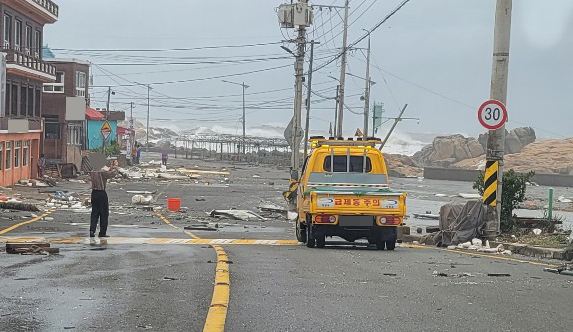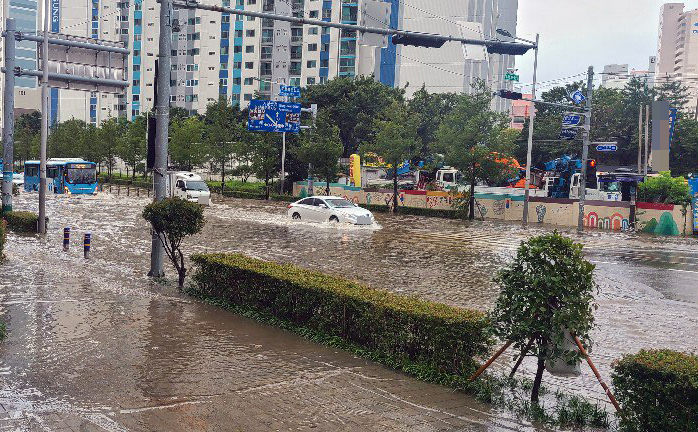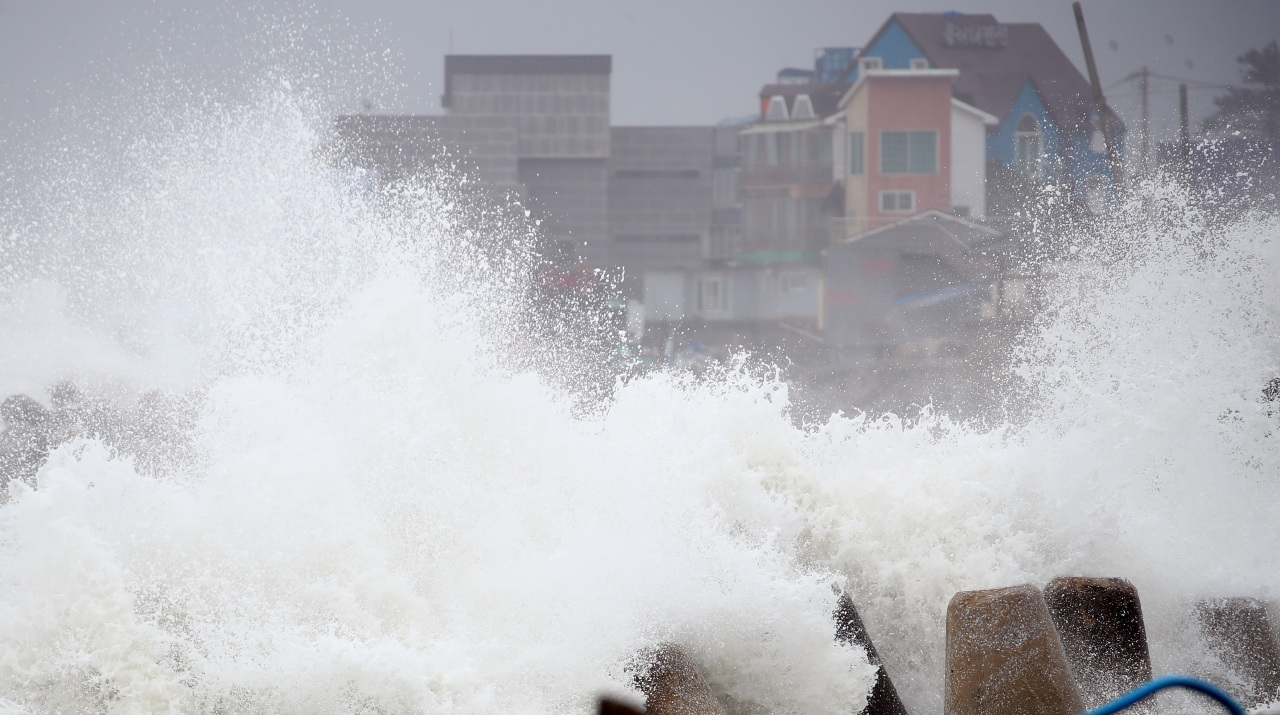
Typhoon Haishen, the season’s strongest storm, left a trail of destruction as it passed through South Korea on Monday.
Several were injured, one went missing and hundreds of cases of property damage, traffic disruptions, and power outages were reported from the southern island of Jeju and the southeastern port city of Busan to Gangneung, Gangwon Province.
The typhoon landed in southern Ulsan at around 9 a.m. and exited through Gangneung at around 1:30 p.m. the same day. As of 4 p.m., Haishen‘s intensity was downgraded to “medium“ and was traveling at sea at a speed of 60 kilometers per hour some 100 kilometers northeast of Sokcho, Gangwon Province.
At least three in Busan and five in Ulsan were injured from the typhoon, according to compiled figures from local governments and municipalities. One was reported missing in Gangwon Province after being swept under heavy rainfall.
One person was injured Monday morning after a car was tipped over from heavy winds in Busan. A man in his 60s was sent to the hospital after he was struck by a flying signboard in the head, and a woman in her 50s also suffered head injuries after falling due to strong winds.
Five people in Ulsan suffered injuries as gusts shattered windows and blew off signboards.
Officials discovered the body of a man in his 50s in Busan at around 1:20 p.m. in waters off Haeundae Beach. The death is yet to be categorized as a typhoon casualty, pending investigation.
Several were injured, one went missing and hundreds of cases of property damage, traffic disruptions, and power outages were reported from the southern island of Jeju and the southeastern port city of Busan to Gangneung, Gangwon Province.
The typhoon landed in southern Ulsan at around 9 a.m. and exited through Gangneung at around 1:30 p.m. the same day. As of 4 p.m., Haishen‘s intensity was downgraded to “medium“ and was traveling at sea at a speed of 60 kilometers per hour some 100 kilometers northeast of Sokcho, Gangwon Province.
At least three in Busan and five in Ulsan were injured from the typhoon, according to compiled figures from local governments and municipalities. One was reported missing in Gangwon Province after being swept under heavy rainfall.
One person was injured Monday morning after a car was tipped over from heavy winds in Busan. A man in his 60s was sent to the hospital after he was struck by a flying signboard in the head, and a woman in her 50s also suffered head injuries after falling due to strong winds.
Five people in Ulsan suffered injuries as gusts shattered windows and blew off signboards.
Officials discovered the body of a man in his 50s in Busan at around 1:20 p.m. in waters off Haeundae Beach. The death is yet to be categorized as a typhoon casualty, pending investigation.

Two power turbines at a nuclear power plant in Gyeongju, North Gyeongsang Province, stopped running temporarily, which officials said was likely due to an external power issue. At least 37,664 households in South Gyeongsang Province and more than 32,000 households in North Gyeongsang Province experienced power outage.
Around 1,640 people from 1,087 households had to evacuate, including 659 people from North Gyeongsang Province, 600 from South Gyeongsang Province and 212 from Busan, according to the Central Disaster and Safety Countermeasure Headquarters.
Some 5,882 schools adjusted school hours or resorted to online learning.

The typhoon also disrupted motor, airway and maritime traffic across the country. Traffic was restricted on 37 roads in affected regions, and nine train routes connecting to and from southern and eastern provinces came to a halt.
All 118 ferries were suspended from operation, and 607 trekking routes at 21 national parks were closed. Around 298 domestic flights were canceled due to the typhoon Monday morning, according to the Korea Airport Corporation, with 121 of them departing from Jeju International Airport.
Ulsan, the city the typhoon was closest to, struggled to keep its electricity supply to households and factories working, with infrastructural damage reported throughout the area.
A flood alert was in effect for hours until noon Monday at the city’s central Taehwa River. Factories belonging to Hyundai Motor and Hyundai Mobis also lost power and are under emergency electricity recovery.
Hyundai Heavy Industries & Construction, which is headquartered in Ulsan, allowed all workers to stay off work for the morning. Some mid-size companies in the city ordered their employees to work at home Monday.
Haishen, the 10th typhoon of the year, arrived when the country was yet to fully recover from typhoons Bavi and Maysak, which swept through the country in the past two weeks.

The latest storm was the strongest this season. It devastated Japan’s Kyushu area before heading toward Korea, recording top winds of 59.4 meters per second at a location in Nagasaki, the strongest in recorded history of Japan. Local media outlets reported that four people went missing, and around 50 people were injured from the typhoon in Japan.
Although the typhoon gradually weakened from a “very strong” intensity to “medium” on its route to Korea, Haishen still carried winds of up to 42.3 meters per second in Pohang, North Gyeongsang Province, and 32.2 meters per second in Busan.
The typhoon made landfall 20 kilometers south of Ulsan city center at around 9 a.m. and exited back to the East Sea around 20 kilometers north of Gangneung at 1:30 p.m.
The national weather agency earlier predicted the tropical storm to skirt the eastern coast of Korea but revised the expected route Sunday evening to a land trek from Ulsan to Gangwon Province.
The Japanese weather agency had anticipated Haishen to directly move along the peninsula after making landfall in South Gyeongsang Province, exiting around Sokcho.
As heavy damage was already expected before the typhoon’s arrival, the Central Disaster and Safety Countermeasure Headquarters was operating with the highest typhoon warning level of its four-tier system of “serious” at 7 p.m. Sunday.
By Ko Jun-tae (ko.juntae@heraldcorp.com)
Although the typhoon gradually weakened from a “very strong” intensity to “medium” on its route to Korea, Haishen still carried winds of up to 42.3 meters per second in Pohang, North Gyeongsang Province, and 32.2 meters per second in Busan.
The typhoon made landfall 20 kilometers south of Ulsan city center at around 9 a.m. and exited back to the East Sea around 20 kilometers north of Gangneung at 1:30 p.m.
The national weather agency earlier predicted the tropical storm to skirt the eastern coast of Korea but revised the expected route Sunday evening to a land trek from Ulsan to Gangwon Province.
The Japanese weather agency had anticipated Haishen to directly move along the peninsula after making landfall in South Gyeongsang Province, exiting around Sokcho.
As heavy damage was already expected before the typhoon’s arrival, the Central Disaster and Safety Countermeasure Headquarters was operating with the highest typhoon warning level of its four-tier system of “serious” at 7 p.m. Sunday.
By Ko Jun-tae (ko.juntae@heraldcorp.com)












![[Today’s K-pop] BTS pop-up event to come to Seoul](http://res.heraldm.com/phpwas/restmb_idxmake.php?idx=644&simg=/content/image/2024/04/17/20240417050734_0.jpg&u=)




![[KH Explains] Hyundai's full hybrid edge to pay off amid slow transition to pure EVs](http://res.heraldm.com/phpwas/restmb_idxmake.php?idx=652&simg=/content/image/2024/04/18/20240418050645_0.jpg&u=20240419100350)

![[Today’s K-pop] Zico drops snippet of collaboration with Jennie](http://res.heraldm.com/phpwas/restmb_idxmake.php?idx=642&simg=/content/image/2024/04/18/20240418050702_0.jpg&u=)